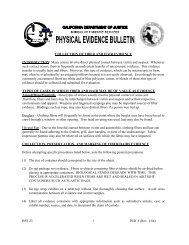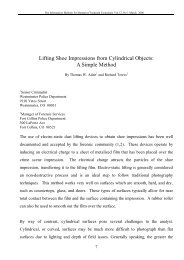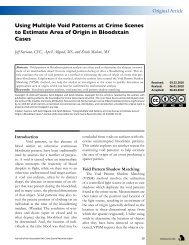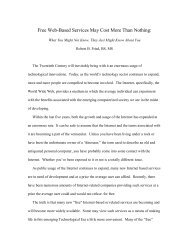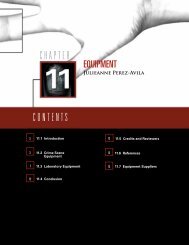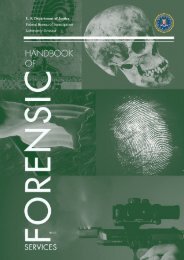PHYSICAL EVIDENCE MANUAL - Crime Scene Investigator Network
PHYSICAL EVIDENCE MANUAL - Crime Scene Investigator Network
PHYSICAL EVIDENCE MANUAL - Crime Scene Investigator Network
You also want an ePaper? Increase the reach of your titles
YUMPU automatically turns print PDFs into web optimized ePapers that Google loves.
Physical Evidence Manual<br />
Adopted: May 2002<br />
Revisions: 6<br />
Last Revision: January 31, 2008<br />
12.0 IMPRESSION <strong>EVIDENCE</strong><br />
Shoe, tire and fabric impressions are routinely present at crime scenes and are<br />
frequently overlooked by law enforcement personnel. In many instances the<br />
examination of these impressions can provide the investigator with valuable<br />
leads such as the type, make/model, and approximate size of the footwear or<br />
tire. If properly documented and collected, almost every impression left by a shoe<br />
or tire has value for forensic comparison to a suspected source. Even when<br />
suspect footwear is not available, images of impressions from scenes may be<br />
submitted to the laboratory for search in the SICAR (Shoeprint Image Capture<br />
and Retrieval) database for make/model determination and comparison to<br />
impressions from other scenes.<br />
Impression Evidence General Guidelines<br />
• Photograph the impression with and without a scale device. The scale<br />
should be a two dimensional ruler.<br />
• Whenever possible, retrieve the original item containing the impression<br />
(e.g. paper, glass, flooring, door) for submission to the laboratory.<br />
• Lift or cast the impression when it is in soil, sand, or snow, or when it<br />
cannot be sent to the laboratory.<br />
Photographic Methods<br />
• Photographs of the evidence should always be taken first before any<br />
attempt to collect it.<br />
• Photograph the general scene that contains the impression evidence.<br />
• Digital photography is acceptable; however, low resolution images may be<br />
of limited use in comparisons. If using a film camera, select a camera with<br />
a large negative format such as 35mm or 4x5 inch. Fine grain black and<br />
white or color film (ISO 125 or less) is preferred.<br />
• Place the camera on a tripod with the camera directly over and<br />
perpendicular to the impression. It is important to avoid taking the photos<br />
at an angle to the impression. This can result in the inability to accurately<br />
enlarge the images as needed for comparison.<br />
• Adjust the camera height so the impression and scale fill the frame.<br />
• Use overlapping exposures to record elongated impressions.<br />
• Use side lighting at various angles and from various directions to<br />
illuminate tread design more clearly. This may require shading the camera<br />
setup from high, bright sunlight with a makeshift tent and access to a<br />
detachable flash unit.<br />
12-1



